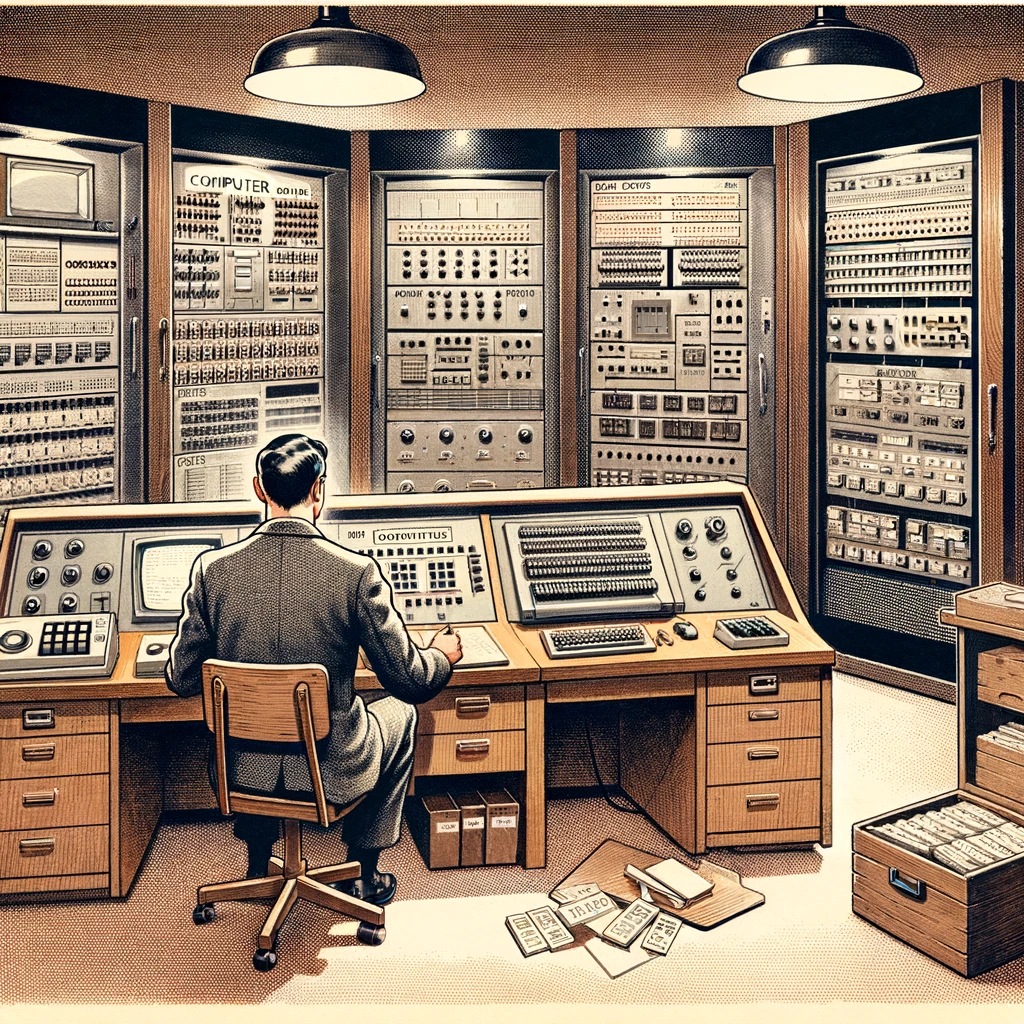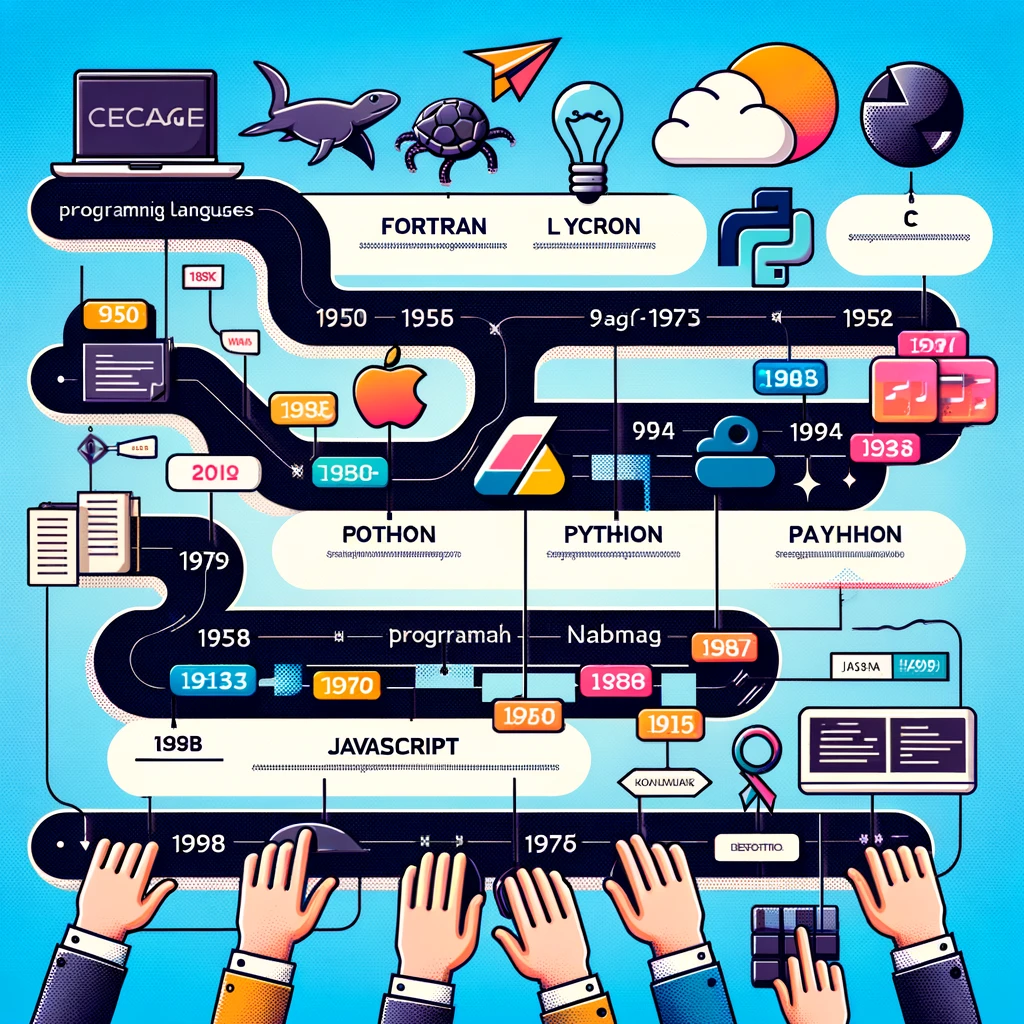Introduction
The story of programming languages is as much about human ingenuity as it is about technological evolution. From the rudimentary binary code used in the earliest computers to the sophisticated and versatile languages of today, the journey of coding languages mirrors the exponential growth of our digital capabilities. This narrative isn’t just about the languages themselves but about the programmers, theorists, and visionaries who saw the potential for machines to do more than calculations—they envisaged a world where computers could assist in solving complex problems, creating art, and connecting people across the globe. As we delve into the evolution of coding languages, we embark on a voyage through time, witnessing the milestones that have shaped the landscape of technology and set the foundation for the future.
The Dawn of Programming Languages
The genesis of programming languages can be traced back to the era of colossal room-sized machines, where the concept of “programming” was synonymous with laboriously configuring vacuum tubes and punch cards. This period marked the utilisation of machine-level languages, where instructions were crafted in binary form, a language of zeros and ones that could directly communicate with the hardware. The enigmatic charm of these early languages lay in their simplicity and direct control over machines, yet they demanded meticulous precision and were unforgiving of errors. The invention of assembly language, a slight abstraction over machine code, introduced symbolic representations, making programming slightly more accessible. Yet, it was the conceptual leap towards creating languages that mirrored human reasoning and logic that truly began to shape the digital landscape.
The Birth of High-Level Languages
The transition from machine and assembly languages to high-level languages marked a pivotal moment in the history of programming. The 1950s saw the emergence of Fortran (Formula Translation), a language designed for numeric and scientific computing. Fortran’s development by IBM was a revolutionary step, demonstrating that computers could be used for more than just arithmetic operations; they could execute tasks expressed in a form that was relatively easier for humans to understand and write. This era also witnessed the creation of COBOL (Common Business-Oriented Language), aimed at business data processing, and LISP (List Processing), the second-oldest high-level programming language, designed for artificial intelligence research. These languages laid the groundwork for the idea that programming could be more intuitive, allowing more people to contribute to computing and software development. The abstraction provided by high-level languages enabled programmers to focus on solving problems rather than wrestling with the intricacies of hardware.

The 1970s and 1980s: A Period of Rapid Development
The 1970s and 1980s were a golden era for the evolution of coding languages, witnessing an explosion of creativity and innovation. The introduction of C in the early 1970s, developed by Dennis Ritchie at Bell Labs, marked a significant milestone. C combined the power and flexibility of assembly language with the readability and efficiency of high-level languages, setting a new standard for software development. Its influence is undeniable, laying the foundation for subsequent languages like C++, which introduced object-oriented programming (OOP) to the C language, enhancing its capabilities and making it more versatile for a wider range of applications.
This period also saw the birth of several other influential languages, each contributing uniquely to the programming landscape. Pascal, developed by Niklaus Wirth, aimed at encouraging good programming practices, while Smalltalk took OOP a step further, influencing the development of many modern programming languages. Moreover, the era welcomed SQL (Structured Query Language), revolutionising how data was managed and manipulated in databases, further illustrating the diversifying needs and applications of programming languages.
Modern Languages and Object-Oriented Programming
As the digital age progressed, the 1990s and beyond saw the advent of languages that further embraced and refined the principles of object-oriented programming. Java, developed by Sun Microsystems, emerged as a powerful, platform-independent language that embodied the write once, run anywhere (WORA) philosophy, making it ideal for the burgeoning internet. Similarly, Python, with its emphasis on readability and simplicity, became beloved by beginners and experts alike for its versatility and ease of use across web development, data analysis, artificial intelligence, and more.
These modern languages benefited from the foundation laid by their predecessors, focusing on improving programmer efficiency and software reliability. The emphasis on OOP principles, such as encapsulation, inheritance, and polymorphism, allowed for the development of more complex, maintainable, and scalable software systems. This era of programming languages demonstrated a clear shift towards making technology more accessible and usable across different platforms and industries.
The Internet Age and Scripting Languages
The explosion of the internet in the late 1990s and early 2000s ushered in a new demand for languages that could handle dynamic content and user interaction on the web. Scripting languages like JavaScript, PHP, and Ruby rose to prominence, each playing a pivotal role in web development. JavaScript, in particular, became a cornerstone of the web, enabling interactive and dynamic content that transformed user experiences online.
The advent of frameworks and libraries in these languages, such as React (JavaScript), Django (Python), and Rails (Ruby), further simplified web development, enabling developers to build complex applications more efficiently. This period highlighted the importance of speed, flexibility, and ease of use, catering to the fast-paced, evolving needs of the digital landscape.

Future Trends in Programming Languages
As we gaze into the horizon of programming languages, several emerging trends hint at a future where coding becomes even more integrated into our digital lives. The pursuit for more efficient, secure, and intuitive programming paradigms is leading the charge towards innovative developments in language design and application.
1. Increased Emphasis on Security and Reliability: In an era where cybersecurity threats are increasingly sophisticated, future programming languages are likely to prioritise built-in security features and robust error-handling mechanisms. Languages such as Rust, which focuses on memory safety without sacrificing performance, are at the forefront of this trend, offering a glimpse into what future coding tools might prioritise.
2. The Rise of Domain-Specific Languages (DSLs): As technology continues to permeate every facet of society, the demand for specialised programming solutions is growing. DSLs are designed to solve specific types of problems efficiently, offering tailored syntax and functionality for particular domains, such as web development, data analysis, or machine learning. This specialisation allows developers to express concepts more naturally within a given context, potentially reducing the complexity and time required for development.
3. Programming for Quantum Computing: With the advent of quantum computing, there’s a burgeoning need for programming languages that can harness the power of quantum mechanics. Languages like Q# by Microsoft are paving the way for developers to explore quantum algorithms, offering constructs that facilitate quantum computation. As quantum computing continues to evolve, programming languages will play a crucial role in bridging the gap between classical computing paradigms and the quantum realm.
4. Enhanced Accessibility and Inclusivity: The future of programming languages also points towards making coding more accessible to a broader audience. Efforts to simplify syntax, enhance educational resources, and develop more intuitive programming environments aim to lower the barrier to entry for coding. This inclusivity not only democratises access to technology creation but also fosters a more diverse community of developers, enriching the ecosystem with a wider range of perspectives and solutions.
As we stand on the cusp of these advancements, it’s clear that the evolution of programming languages is far from complete. The journey from binary to beyond continues, driven by the relentless pursuit of innovation and the ever-changing landscape of technological needs.
Conclusion
The history of programming languages is a testament to human creativity and our quest to communicate more effectively with machines. From the rudimentary binary codes of the early computing era to the sophisticated languages of today, each development has paved the way for new possibilities in technology and beyond. As we look forward to the future trends in programming languages, it’s evident that this evolution will continue to shape our digital world, making technology more powerful, accessible, and aligned with the diverse needs of society. Let’s embrace the changes on the horizon with anticipation and a commitment to learning, ensuring that we’re ready to contribute to the next chapter in the story of programming languages.
FAQs
1. What was the first programming language? The first high-level programming language is often considered to be FORTRAN, developed in the 1950s by IBM. It was designed for scientific and engineering calculations and marked a significant departure from machine and assembly languages, enabling more abstract and efficient coding.
2. How have programming languages evolved to meet the needs of modern computing? Programming languages have evolved significantly from the early days of binary and assembly languages to modern high-level languages that prioritise readability, efficiency, and cross-platform compatibility. The development of object-oriented programming, scripting languages for web development, and languages focused on security and concurrency reflects the changing landscape of technology and the diverse needs of applications today.
3. Are older programming languages still in use today? Yes, many older programming languages are still in use today. Languages such as COBOL and Fortran, while considered legacy languages, are still critical in certain industries like finance, aerospace, and scientific research due to their stability and the vast amount of legacy code that relies on them. Modern languages often build upon the concepts introduced by their predecessors, ensuring a degree of continuity in programming paradigms.
4. What role do programming languages play in the development of artificial intelligence? Programming languages are fundamental to the development of artificial intelligence (AI). Languages like Python have become particularly popular in AI development due to their simplicity, extensive libraries, and frameworks that support machine learning, natural language processing, and data analysis. The evolution of programming languages continues to enable more sophisticated and efficient AI algorithms, driving innovation in the field.
5. How can someone keep up with the rapidly changing landscape of programming languages? Keeping up with the rapidly changing landscape of programming languages can be challenging but rewarding. Engaging with developer communities, participating in coding workshops, and following technology news can help. Additionally, exploring open-source projects and experimenting with new languages and frameworks can provide practical experience and insights into emerging trends.


This article provides a clear and concise overview of the evolution of programming languages. It effectively highlights the key milestones and concepts that have shaped the development of programming.
While the article covers the basics of programming language evolution, it fails to explore some of the more controversial or debated topics, such as the relative merits of different programming paradigms.
The article accurately describes the evolution of programming languages, but it could benefit from providing more concrete examples of how specific languages have influenced the development of software applications.
The author claims that OOP is the pinnacle of programming paradigms, but I believe that functional programming offers a more elegant and maintainable approach to software development.
So, programming languages have evolved from 0s and 1s to… more 0s and 1s? How exciting!
The future of programming languages is bright, as long as we keep reinventing the wheel with every new language that comes along.
I bet the first programmers had to write their code on stone tablets with a chisel.
I’m new to programming, and this article made my head spin. Can someone explain it to me in simpler terms?
The evolution of programming languages is a testament to the creativity and problem-solving abilities of human minds. I’m excited to see what the future holds for this ever-evolving field.
The article presents a somewhat linear view of programming language evolution, but I believe there have been periods of convergence and divergence in the development of different languages.